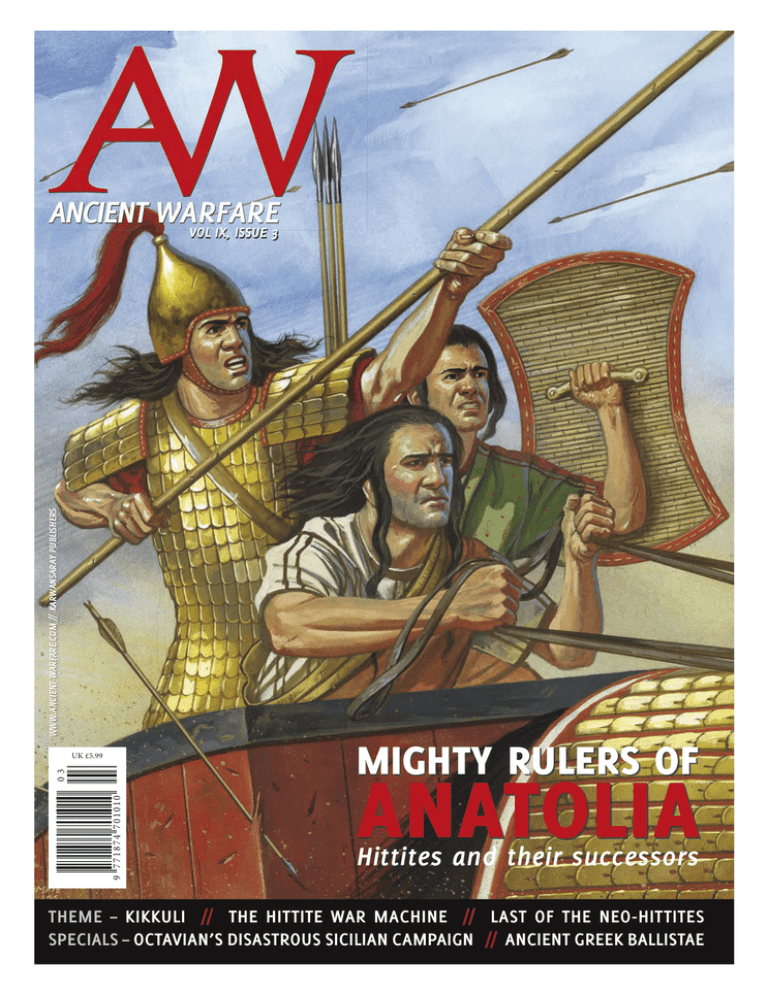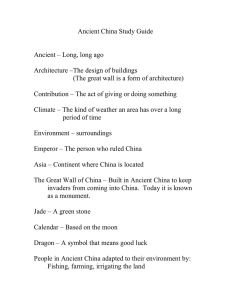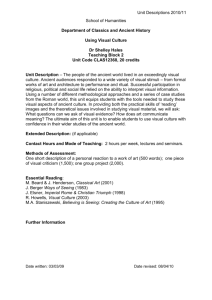
9 771874 701010
03
UK £5.99
>
www.ancient-warfare.com // Karwansaray PublisHers
Vol iX, issue 3
mighty rulers of
AnAtoliA
Hittites and their successors
Theme – KiKKuli // The hiTTiTe war machine // lasT of The neo-hiTTiTes
specials – ocTavian’s disasTrous sicilian campaign // ancienT greeK ballisTae
aw_9-3.indd 1
24/06/15 15:01
aw_9-3.indd 2
24/06/15 15:01
Publisher: Rolof van Hövell tot Westerflier
Managing Director: Jasper Oorthuys
Editor: Josho Brouwers
Design & Media: Christianne C. Beall
Design © 2013 Karwansaray Publishers
theme: e mightly rurs of anatoa
Proofreaders: Christianne C. Beall, Marc G. DeSantis,
Arianna Sacco
Anatolia, the gateway between Europe and the Near East, was
home to a variety of peoples, most notably the powerful Hittites.
Contributors: Eric B. Anderson, Duncan Campbell,
Sidney Dean, Marc G. DeSantis, Robert Holmes, Sean
Manning, Konstantin Nossov, Lindsay Powell (news),
David L. Reinke, Arianna Sacco, Steven Weingartner.
Illustrators: Carlos García, Rocío Espin, Milek
Jacubiec, Julia Lillo, Angel García Pinto, Maxime
Plasse, Johnny Shumate.
Print: Grafi Advies
Editorial office
PO Box 4082, 7200 BB Zutphen, The Netherlands
Phone: +31-575-776076 (NL), +44-20-8816281
(Europe), +1-740-994-0091 (US)
E-mail: editor@ancient-warfare.com
Customer service: service@karwansaraypublishers.com
Website: www.ancient-warfare.com
Contributions in the form of articles, letters, reviews,
news and queries are welcomed. Please send to the
above address or use the contact form on
www.ancient-warfare.com
Subscriptions
Subscriptions can be purchased at
www.kp-shop.com, via phone or by email. For the
address, see above.
Distribution
Ancient Warfare is sold through retailers,
the internet and by subscription. If you wish
to become a sales outlet, please contact us at
service@karwansaraypublishers.com
Copyright Karwansaray B.V. All rights reserved. Nothing
in this publication may be reproduced in any form
without prior written consent of the publishers. Any
individual providing material for publication must
ensure that the correct permissions have been obtained
before submission to us. Every effort has been made
to trace copyright holders, but in few cases this proves
impossible. The editor and publishers apologize for any
unwitting cases of copyright transgressions and would
like to hear from any copyright holders not acknowledged. Articles and the opinions expressed herein do
not necessarily represent the views of the editor and/
or publishers. Advertising in Ancient Warfare does not
necessarily imply endorsement.
6
hittites and their successors
Historical introduction
24 bronze age superpower
The Hittite war machine, 1700–1200 BC
10 The hittite guards’ rule
32 rise and fall of minor kingdoms
13 hittite defensive structures
38 The armourers of caria
Reading a Hittite clay tablet
The Bronze Age art of fortification
Last of the Neo-Hittites
A Greek tradition of Anatolian invention
18 Kikkuli
A horse master from Mitanni
Speal as
40 against pompeius
50 hollywood romans
Octavian’s disaster in Sicily
Cleopatra, the eternal queen
45 euthytones and palintones
What did the ballista really look like?
Departs
4
news & letters
58 on the cover
Opinions and recent developments
The Hittite war chariot
53 reviews
Books, games and media
10
24
38
the guArds’ rule
hittite wAr mAChine
CAriAn Armourers
Ancient Warfare is published every two months by
Karwansaray B.V., Rotterdam, The Netherlands.
PO Box 1110, 3000 BC Rotterdam, The Netherlands.
ISSN: 2211-5129
Printed in the European Union.
Hittite clay tablets reveal that
military traditions have remained constant for millennia.
The Hittite Empire created a
mighty army and built impressive fortifications.
The Greeks believed that
some of their military kit had
been invented by Carians.
ancient warfare iX-3
aw_9-3.indd 3
3
24/06/15 15:01
News & letters
ws & ers
editorial
Every volume of Ancient Warfare follows a set
structure as regards themes. There are always
two themes each dedicated to the Greeks
and the Romans (since we have so much
material to work with). Then there’s always
one issue that deals with a general theme,
such as logistics or light infantry, and finally
an issue that deals with a non-Greco-Roman
theme. I always think the latter are the most
challenging and perhaps the most interesting
to deal with from an editorial point of view.
This issue – on the Hittites and their successors – has proven to be no different.
I think the range of articles turned out
to be quite varied and interesting, with some
focusing on clay tablets and other written
sources, while others are more archaeological. For this issue, I’ve also done something
a little different with regards to the centrefold: instead of doing another battle scene,
I figured it would be more informative to
feature a reconstruction drawing of the Hittite capital of Hattusa instead, created by the
talented Rocío Espín (she’s previously done,
among other things, a beautiful reconstruction of Jerusalem in issue VIII.5, and one of
the Hyksos capital of Avaris in issue VII.1).
As always, I hope you will enjoy reading
this issue of Ancient Warfare. If you have
any comments or suggestions for improvement, feel free to contact me. The easiest
and most direct way to contact me is by
email: editor@ancient-warfare.com
And if you can’t get enough of the ancient world, don’t forget that Karwansaray
Publishers has an extensive website with
sections dedicated specifically to Ancient
Warfare as well as to our brand new sister magazine, Ancient History Magazine.
Jona Lendering, co-editor of AHM, blogs
at least once a week on the AHM website.
I also write blog posts for both the AHM
and Ancient Warfare websites. The AHM
site also has a page with links to online resources on the ancient world. The Ancient
Warfare site lists our most recent podcasts
too, and we are in the process of putting
all of the reviews from older issues of Ancient Warfare online for everyone to enjoy.
— Josho Brouwers
Editor, Ancient Warfare
ancient warfare, now as then, in glorious technicolour
Some of the best parts of Ancient Warfare
magazine are the wonderful artworks. Talented artists reimagine warriors and battles,
bringing the world of Antiquity to life for the
reader. All of them are in full colour. That
begs a question: when most of the source
materials that have come down to us are
stone or verdigris bronze, how do they
know what colours or patterns to use? A
visit to the special exhibition, Gods in Colour: Painted Sculpture in Antiquity at the
Ashmolean Museum in Oxford, England,
provided some of the answers.
It has been known for some time that
statues and stelae in ancient Greece and
Rome were highly decorated with colour;
they were never plain white. This exhibi-
4
aw_9-3.indd 4
tion displayed fully coloured reconstructions painted with authentic pigments and
presented them complete with additions in
other materials, such as metal eyelashes or
eyes inlaid with glass and stone.
Their ancient creators intended to
represent life as truthfully as possible. Artists of the Archaic period of Greek history
(seventh–sixth centuries BC) often used
un-naturalistic colours to give prominence
to rare and expensive pigments or precious
materials such as gold leaf, but during the
Classical and later periods (fifth century
BC and after), colourization became more
naturalistic. The original colours have usually faded from long exposure to the elements, but in a few cases traces of paint
ancient warfare iX-3
24/06/15 15:01




